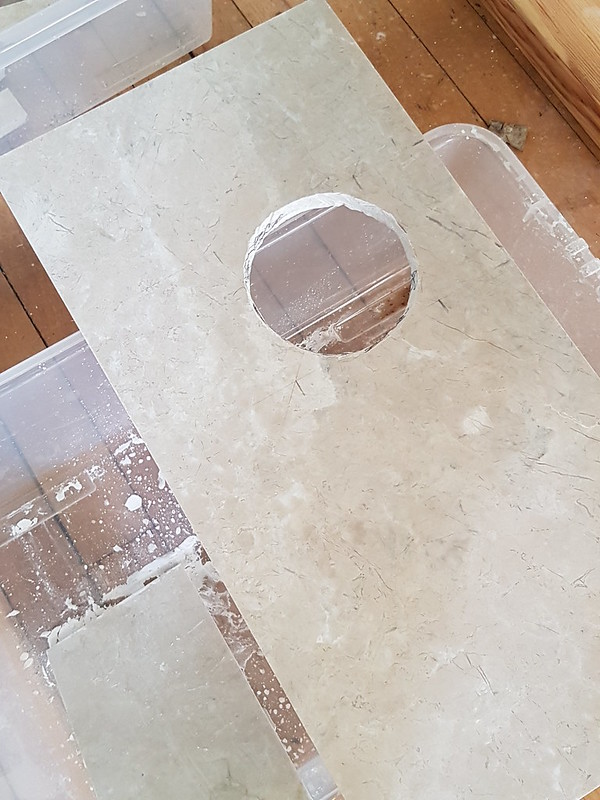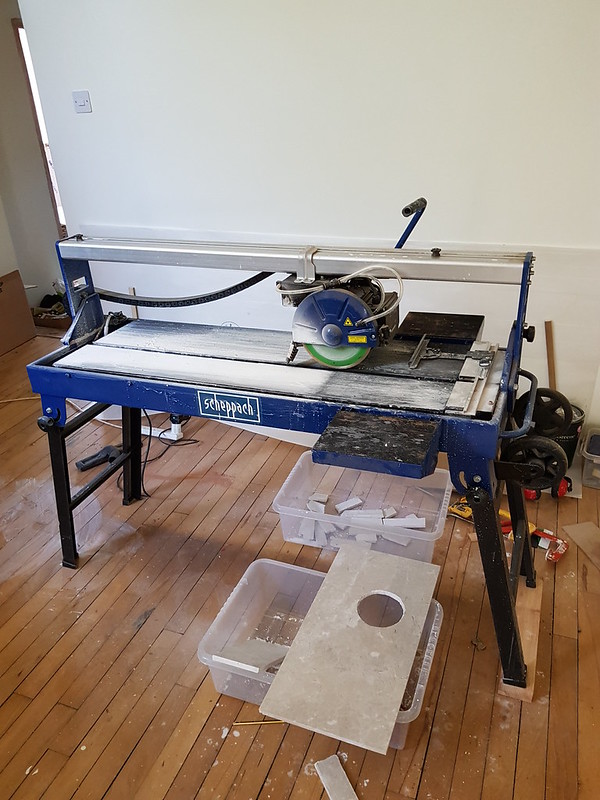Hole cut in the 'proper' tile. A few comments for anyone thinking about doing this for themselves.
Geometry is your enemy. The initial cut made to define the circle is very easy to do and because you're only kissing the surface (or should be !) then the grinder/diamond blade can be almost vertical. In the video, it looks as if he's resting part of the grinder as a pivot point. I tried that but that wasn't easy on my grinder as there was no obvious point on it to act as the pivot. I was also concerned about the grinder running away across the tile. So I held it by using a pair of those orange 'sticky' gloves and using my hand/knuckle as the pivot.
The difficulty starts to come as the depth of cut progresses. Because of the diameter of the blade, while you're focussing on the leading edge as you go round making the next shallow cut, if you're not careful then the trailing edge of the blade will start cutting where you don't want it. To get round that, you gradually end up holding the blade at an angle and grinding away a bevel on the inside. That's not a problem but what you end up with is an opposite bevel on the tile surrounding the hole. Once you've finally cut all the way through then you are left with this bevel that now needs removing (unless the dimensions of whatever you're cutting the hole to fit allow you to make the circle much larger than you'd think).
So you can turn the tile over and carefully nibble way some of the bevel using the edge of the blade. But again geometry is a problem as you still have to be careful what that trailing edge of the blade is doing. In an ideal world one could buy a blade that had a much smaller diameter (but then the grinder itself would probably be prohibiting!).
Or a drum sander - covered in fine diamonds. I tried using a hole cutter and running the diamond embedded on the side to grind the bevel away but there simply wasn't enough meat on the cutter and it kept slipping away. Possibly clamping a portable drill upside down with the cutter adjusted to the right height, flipping the tile over and grinding the bevel away might work but if it's a thick tile then you'll be forever adjusting the height of the cutter.
Or you might think one of those Vitax diamond tile files would be the answer. It isn't. The diamonds on those files are just to coarse and the tile just skips over and des SFA. A horrible tool.
The answer (for me) was the trusty Dremel (other makes are available) and a diamond cylinder that I think might have been originally intended for sharpening a chainsaw blade. Any road, that worked a treat and is my preferred way.
It has also been suggested to adjust the tile positioning so that you can get in there with a tile saw and cut two semi-circles in two tiles to come together to form your hole. Yes..but if the tiles are very large then you can't easily get the tile saw handle all the way round. Plus if they are natural tiles, such as marble, then there are hidden flaws...the integrity in the tile as a whole keeping it all together but as soon as you start cutting that semi-circle, leaving those two 'wings' then if there is a hidden flaw in the wing it will break.






